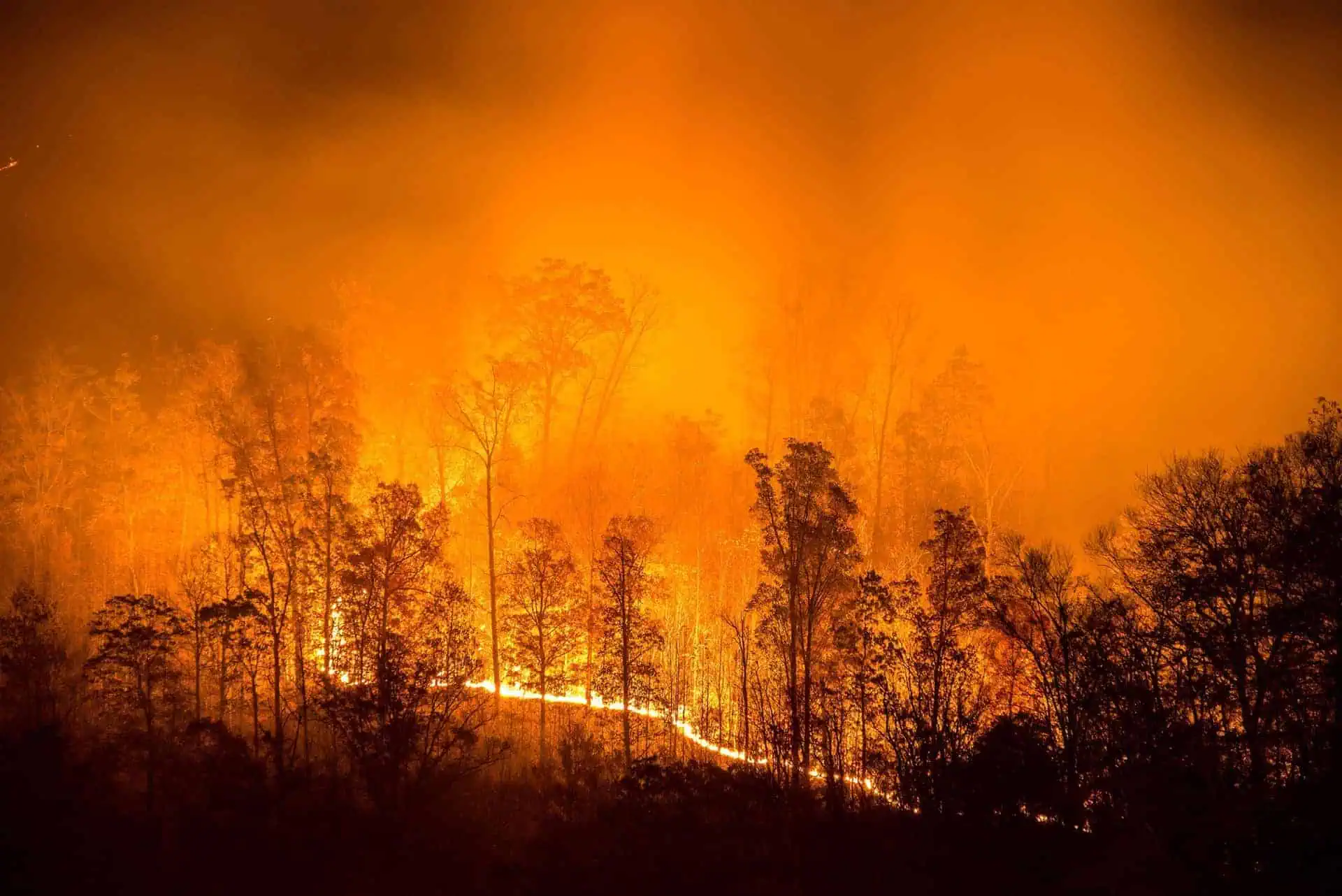FAQ: What Caused The Fire In Maui?
- Last Updated: June 12th, 2025

Attorney Jessica Paluch-Hoerman, founder of TruLaw, has over 28 years of experience as a personal injury and mass tort attorney, and previously worked as an international tax attorney at Deloitte. Jessie collaborates with attorneys nationwide — enabling her to share reliable, up-to-date legal information with our readers.
Legally Reviewed
This article has been written and reviewed for legal accuracy and clarity by the team of writers and legal experts at TruLaw and is as accurate as possible. This content should not be taken as legal advice from an attorney. If you would like to learn more about our owner and experienced injury lawyer, Jessie Paluch, you can do so here.
Fact-Checked
TruLaw does everything possible to make sure the information in this article is up to date and accurate. If you need specific legal advice about your case, contact us by using the chat on the bottom of this page. This article should not be taken as advice from an attorney.
Key takeaways:
- The devastating Maui fires were influenced by a combination of weather conditions, including strong winds, dry vegetation, and low humidity.
- Reports suggest that bare electrical wire that could spark on contact and leaning poles on Maui were potential causes.
- Some evidence suggests that sparks produced by a downed power line may have ignited at least one of the fires.
Overview of What Caused The Fire In Maui?
Question: What caused the fire in Maui?
Answer: The cause of the fire is currently under investigation, with Hawaii Electric and local residents playing a significant role in the process.
Preliminary findings suggest that human activity may have played a role in the fire’s ignition, but comprehensive investigation results have not yet been released.
Intro to What Caused The Fire In Maui
Further analysis of this incident, which has had a substantial impact on Maui, will be provided in due course.
The Lahaina fire, which occurred on the island of Maui, began under conditions that were conducive for wildfires – high temperatures, dryness, and strong winds.
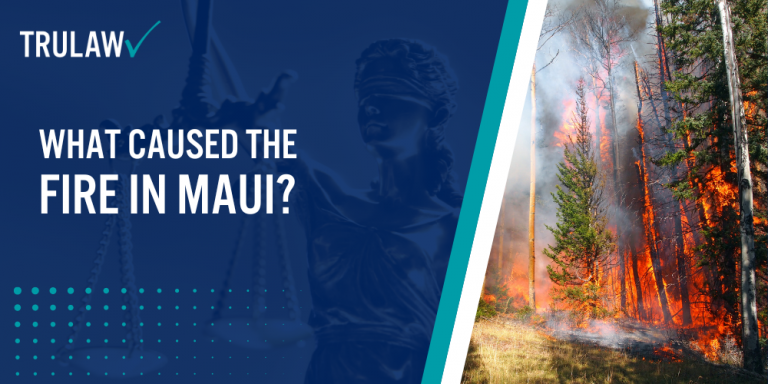
The fire was first detected around noon near Lahaina, a town frequented by tourists due to its scenic beaches and historical landmarks.
Emergency personnel were immediately dispatched to the scene, but their firefighting efforts were complicated by several factors.
The dense smoke and high temperatures made it difficult for them to navigate the area and control the fire.
The situation was further exacerbated by the winds that fueled the fire and caused it to spread erratically over the island’s uneven landscape.
Unfortunately, despite the efforts of the first responders, the fire caused extensive damage to the local ecosystem.
Table of Contents
Investigating the Lahaina Incident
The role of weather conditions cannot be understated in this incident.
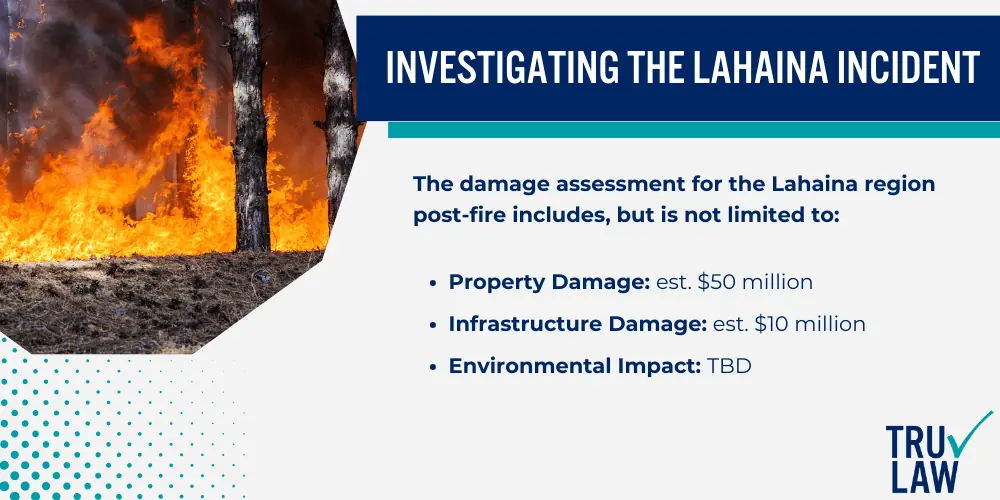
Hurricane Dora brought with it not just powerful winds but also extremely dry air which exacerbated the situation significantly:
- According to meteorological data from that day, wind speeds were recorded at over 60 miles per hour.
- The humidity levels were shockingly low for this tropical region – hovering around 20%.
These harsh weather conditions created a perfect storm for rapid fire spread.
Damage Assessment
The damage assessment for the Lahaina region post-fire includes, but is not limited to:
- Property Damage: est. $50 million
- Infrastructure Damage: est. $10 million
- Environmental Impact: TBD.
This only scratches the surface of the true cost – there are numerous intangible losses such as loss of life, displacement of residents, trauma and psychological impact which are difficult to quantify.
Firefighting Efforts
The efforts to combat the fire in Lahaina were commendable.
The firefighters worked tirelessly, facing not only the fire but also unfavorable weather conditions.
However, the task of controlling the fire was challenging due to the strong winds that complicated the containment of the flames.
Details of the Lahaina wildfires investigation include:
- Lahaina saw the deployment of 50 fire trucks for this operation.
- The firefighting force comprised more than 200 individuals for this specific area.
Despite these obstacles, the firefighters were successful in halting the further spread of the fire and ultimately putting it out.
Kula Residents: The Human Impact
The severe fire incident that occurred in Maui, particularly in the upcountry region, led to the evacuation of a significant number of inhabitants from Kula.
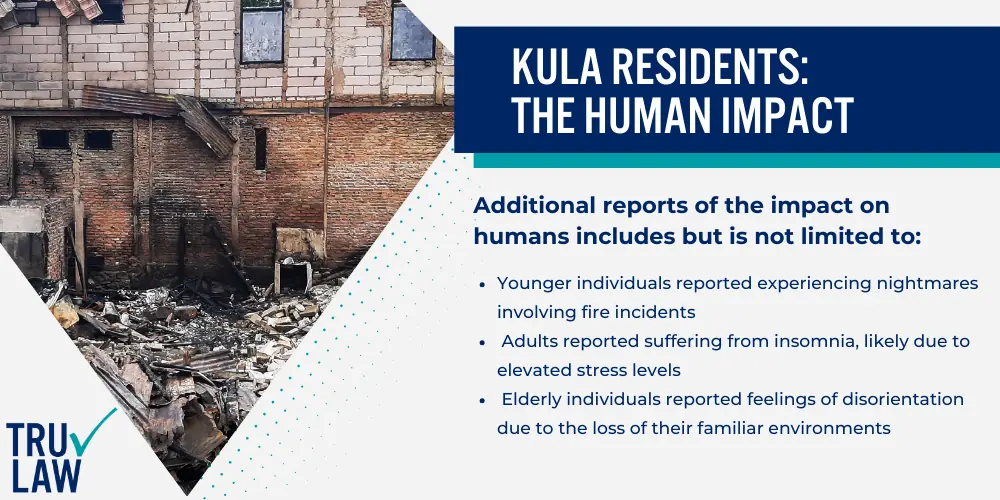
According to the county’s data, around 30 percent of the town’s total population were compelled to leave their residences.
This evacuation process not only involved the loss of their homes but also the abandonment of items of both sentimental and financial importance, such as:
- An inherited family object passed down over the years.
- Vital paperwork such as birth certificates or property ownership documents.
- Automobiles, a crucial mode of transport for many.
The distress of these losses was further exacerbated by the uncertainty of when they would be able to return and the state of what they would find upon their return.
Emotional Toll on Individuals and Families
The fire resulted in significant emotional distress for those affected, beyond the tangible losses.
A multitude of individuals experienced traumatic responses after witnessing their homes consumed by fire, while others were faced with anxiety concerning their unpredictable futures.
The local bird sanctuary, a symbol of tranquility for the residents, was also in peril, further exacerbating the community’s emotional distress.
Additional reports of the impact on humans includes but is not limited to:
- Younger individuals reported experiencing nightmares involving fire incidents.
- Adults reported suffering from insomnia, likely due to elevated stress levels.
- Elderly individuals reported feelings of disorientation due to the loss of their familiar environments.
This emotional impact serves as a stark indication that disasters have repercussions beyond the destruction of physical infrastructure, also deeply affecting the lives of individuals.
Losses Incurred by Residents
The extent of the damages suffered by the inhabitants was contingent on several factors, including their proximity to the fire and the local humidity levels, which affected the speed at which the fire spread.
Nonetheless, every resident in the affected area likely experienced some degree of loss:
- Residences were either completely devastated or partially damaged.
- Personal possessions were completely destroyed.
- Home-based businesses or farms, which were the primary sources of income for many, were severely affected.
For those who lost everything, the task of rebuilding from ground zero is daunting, made even more challenging due to limited resources and the ongoing concerns about climate change.
Health Impacts Due to Smoke Inhalation or Injuries
The fire resulted in not only significant property damage, but also presented considerable health hazards.
Numerous residents experienced smoke inhalation, leading to respiratory complications.
Some individuals incurred injuries in their attempts to retrieve their possessions or extinguish smaller fires using the water resources at their disposal.
These injuries may include but are not limited to:
- Incidence of asthma attacks due to heavy smoke exposure.
- Burns resulting from direct interaction with fire.
- Illnesses induced by stress, including heart conditions.
These health consequences highlight the importance of having sufficient emergency medical services in such circumstances.
Power Lines: Sparking the Fire in Maui?
Power lines are an important factor in the ignition of wildfires.
The structures supporting these lines, known as power poles, are vulnerable to environmental conditions such as high winds, which can lead to the lines falling.
When these energized wires come into contact with dry vegetation, they have the potential to start fires.
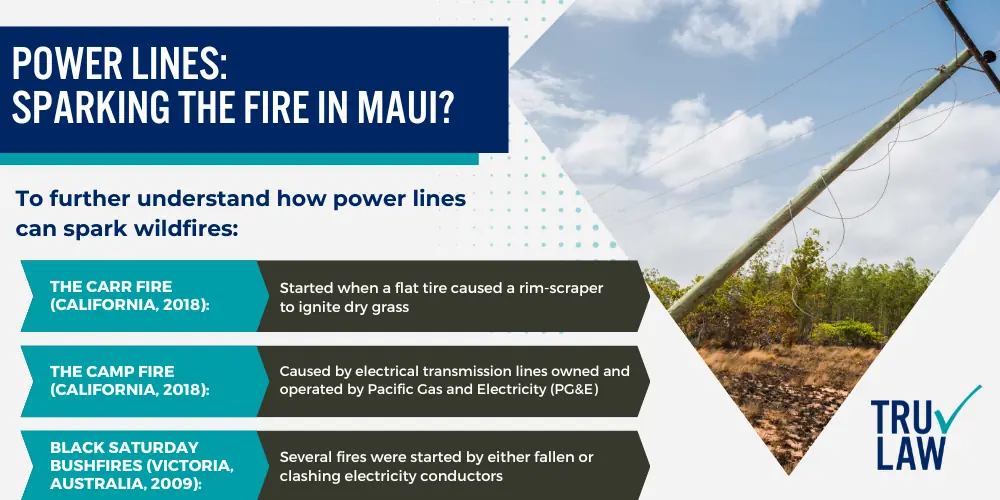
This was the case in the 2018 Camp Fire in California, the state’s most deadly wildfire to date.
The state fire department concluded that the fire was initiated by Pacific Gas & Electric Co.’s electrical equipment.
A similar situation was found in Australia, where investigations into the Black Saturday bushfires determined that a number of the fatal fires were started by malfunctioning power line equipment.
In the case of the Maui fire incident, there have been suggestions of power line involvement.
Witnesses reported seeing sparks from power lines at the time the fire broke out.
However, the physical evidence is still being scrutinized by the relevant authorities.
Case Studies: Power Line-Induced Fires
To further understand how power lines can spark wildfires:
- The Carr Fire (California, 2018): Started when a flat tire caused a rim-scraper to ignite dry grass.
- The Camp Fire (California, 2018): Caused by electrical transmission lines owned and operated by Pacific Gas and Electricity (PG&E).
- Black Saturday Bushfires (Victoria, Australia, 2009): Several fires were started by either fallen or clashing electricity conductors.
These case studies underscore how seemingly innocuous incidents involving electricity infrastructure can rapidly escalate into full-blown wildfires.
Safety Protocols and Precautionary Measures
Hawaii Electric has stringent safety protocols regarding power line maintenance to prevent such incidents from occurring:
- Regular inspection of all electrical equipment
- Pruning trees near power lines
- Installing animal guards on equipment
- Upgrading older equipment with new, safer models
- Regular training of staff on safety measures
Despite these protocols, the Maui fire incident has raised questions about their effectiveness and whether more could be done to prevent such occurrences.
The power company is working closely with the fire department in their investigation.
Emergency alerts were sent out promptly when warning sirens indicated a potential wildfire.
High winds at the time of the incident are also being examined as a contributing factor to the Maui fire.
Data and Evidence: Confirming Causes
The process of identifying the cause of the Maui fire necessitates the analysis of scientific data.
This encompasses measurements of temperature, wind velocity, humidity, and other prevailing weather conditions at the time of the incident.
For example, elevated temperatures are frequently a significant factor in the occurrence of wildfires.
In this instance, temperature measurements obtained from meteorological stations across Maui in the days before the fire indicated a notable rise in heat.
The velocity of the wind is another critical element in the propagation of fires.
The data gathered demonstrated that wind velocities were considerably higher than the average on the day of the fire.
Expert Analysis on Fire Behavior
Fire behavior specialists offer crucial knowledge about the initiation and progression of fires.
They conduct a detailed examination of factors such as the types of fuel, geographical features, and meteorological conditions to ascertain probable causes.
Upon scrutinizing the Maui fire, the specialists made several important observations:
- The existence of vegetation with high combustibility in the vicinity.
- The undulating landscape which can hasten the spread of fire.
- The dominant wind direction which transported burning fragments to fresh areas.
These observations imply that environmental conditions significantly contributed to the ignition and propagation of this specific fire.
Physical Evidence from Scene Supports Cause Determination
The collection of physical evidence from the site can assist in affirming the cause of the fire that occurred in Maui.
The patterns of burns provide indications about the origin of the fire and its path of spread.
In this particular instance:
- The presence of deep burns near the bases of trees suggests that the fuels on the ground played a significant role in the initial ignition.
- The occurrence of V-shaped burn patterns directed towards certain directions indicates the spread of fire driven by wind.
- The existence of scorch marks on the trunks of the trees shows high-intensity burning, which is a characteristic of crown fires (fires that spread through the tops of trees).
This physical evidence corroborates the expert analysis that suggests the local vegetation served as fuel for this catastrophic event.
Role of Local Weather Conditions
In the context of fires, local weather conditions frequently have a significant impact.
This was indeed the case with the Maui fire, where numerous weather-related elements were involved:
- Drought Conditions: The period preceding the fire was characterized by less rainfall than usual, resulting in dry vegetation that was susceptible to ignition.
- Elevated Temperatures: As previously noted, there was a rise in temperature during this time.
- Powerful Winds: Data on wind speed revealed that the winds were strong and gusty, which facilitated the rapid spread of the fire.
These factors not only facilitated the ignition of the fire but also amplified its impact by enabling it to spread swiftly and intensely.
Hawaii Electric's Alleged Responsibility
The severe fire incident that occurred in Maui has been under rigorous examination and inquiry.
The central focus of these inquiries has been the electric company, Hawaii Electric (also known as HECO), due to initial claims suggesting their potential negligence.
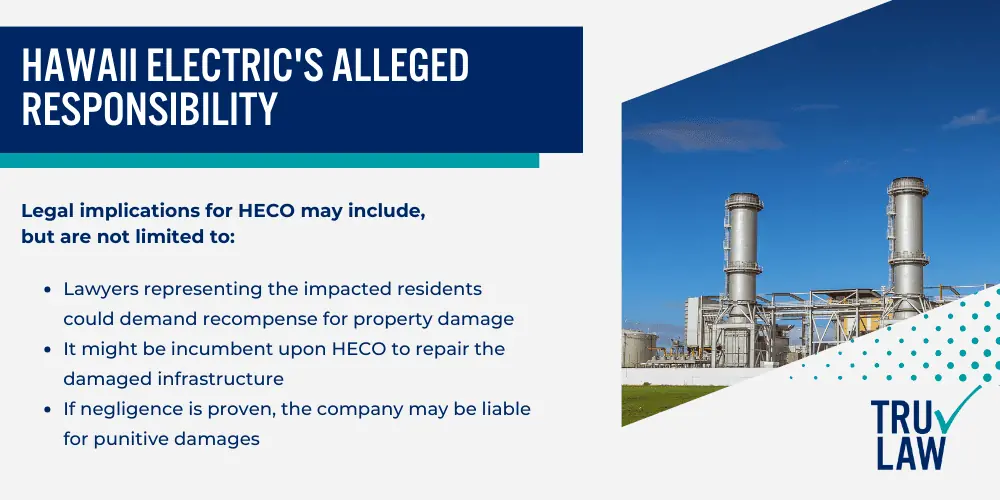
These claims originated from multiple eyewitness testimonies that stated that the initial signs of the disastrous fire were sparks from a transformer belonging to the company.
As an organization responsible for the supply of electricity throughout the region, HECO is expected to ensure proper maintenance of its equipment.
If these claims are substantiated, it could imply a significant failure in upholding this duty.
It would then be necessary to investigate the following:
- If there were any reported maintenance problems before the fire incident.
- Whether the transformer was scheduled for an inspection or replacement.
- Whether there were any breaches of safety protocols prior to the incident.
Evidence and Possible Negligence
The inquiry into the cause of the Maui fire has uncovered further evidence that suggests possible culpability on the part of HECO.
Multiple residents have reported witnessing sparks emanating from a transformer just prior to the fire consuming the surrounding vegetation.
Additionally, investigators discovered remnants of charred electrical wiring near the fire’s point of origin.
It is essential to refrain from drawing premature conclusions until the release of official reports.
However, the gathered evidence does prompt questions about HECO’s involvement in this unfortunate incident:
- Was there an occurrence of a power surge that resulted in overheating?
- Is it possible that obsolete equipment played a role in the sparking?
- Were there any previously identified issues with this specific transformer?
Legal Implications for HECO
Should inquiries establish that HECO’s negligence was the cause of the extensive fire in Maui, they may face significant legal issues.
They could be subject to substantial fines and penalties under state laws that regulate public safety and utilities management.
Legal implications for HECO may include, but are not limited to:
- Lawyers representing the impacted residents could demand recompense for property damage.
- It might be incumbent upon HECO to repair the damaged infrastructure.
- If negligence is proven, the company may be liable for punitive damages.
Public Sentiment Post-Incident
Following the incident, there has been a surge in negative public sentiment towards HECO.
A significant proportion of the local population believes that the electric company should be held responsible if their equipment was indeed the cause of the fire.
Online platforms, including social media, have become hotbeds for discussions and debates regarding HECO’s purported involvement in the incident.
Some users are demanding that the company be held accountable and transparent in their dealings.
However, the following points must be taken into consideration:
- The public’s reaction is often immediate and may not encompass the entire situation.
- If found guilty, HECO should certainly be held accountable, but it is equally important to allow them an opportunity to explain their perspective.
- An open conversation between HECO and the affected residents could lead to more effective problem-solving strategies in the future.
Countering Claims: Hawaii Electric's Response
In response to inquiries regarding the fire incident in Maui, Hawaii Electric has released an official statement.
The company has been facing allegations of potential involvement or negligence in the incident, which they have firmly denied.
The statement reads in part:
“We acknowledge the circulating speculations and worries about our possible role in this unfortunate occurrence.”
It further states:
“Our initial investigations do not suggest any malfunction or failure on our part.”
The company has taken the opportunity to emphasize their commitment to safety, stating that they have robust safety measures in place.
They assert that these measures were fully operational at the time of the incident.
Safety Measures Pre-Incident
Hawaii Electric has provided a detailed account of the safety measures it had implemented prior to the occurrence of the fire.
These precautions, as stated by the company, are part of their standard operating procedure aimed at preventing such incidents.
The first measure involves the regular inspection and maintenance of power lines.
This is done to ensure that any potential faults or issues that could lead to a fire are identified and addressed promptly.
Secondly, the company has installed advanced fire detection systems.
These systems are designed to quickly detect any signs of a fire, allowing for swift action to be taken to prevent it from spreading.
The third measure is the training of staff on emergency response procedures.
This is to ensure that in the event of a fire, staff are well-equipped to respond effectively and efficiently, minimizing the potential damage.
Lastly, the company ensures full compliance with all regulations set by the utilities commission.
This is to ensure that all safety standards and requirements are met.
Through their detailed account, Hawaii Electric has demonstrated its commitment to safety and regulatory compliance.
Post-Incident Actions
In response to the public outcry and criticism following the fire incident in Maui, Hawaii Electric took immediate action.
The company’s initial response was to release a public statement, acknowledging their awareness of the situation.
This was followed by the launch of an internal investigation.
In addition, Hawaii Electric also fully cooperated with external investigators who were looking into the incident.
Furthermore, the company pledged to rectify any faults found during the investigation and to improve their preventive measures.
This proactive approach by Hawaii Electric demonstrated their accountability and their commitment to addressing the concerns of the public.
Cooperation with Authorities
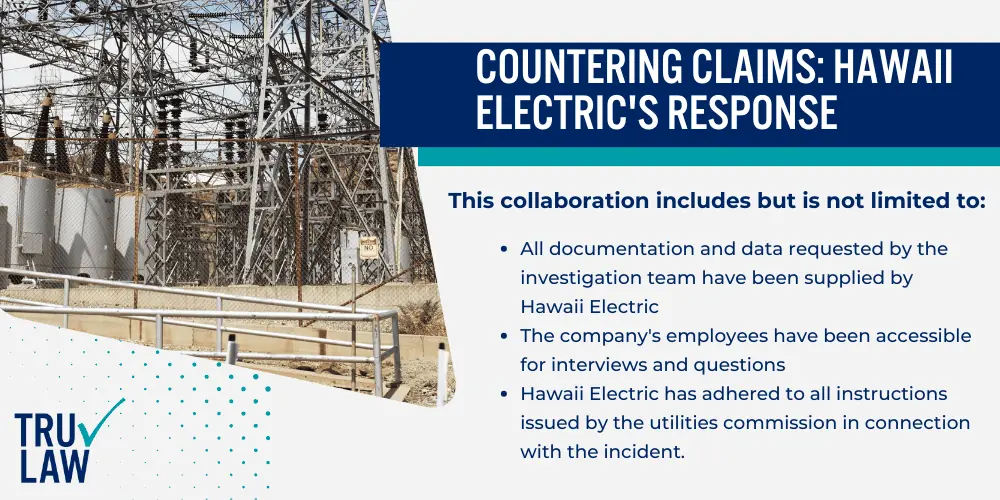
Hawaii Electric has been actively collaborating with the investigative authorities since the initial day following the fire incident.
This collaboration includes but is not limited to:
- All documentation and data requested by the investigation team have been supplied by Hawaii Electric.
- The company’s employees have been accessible for interviews and questions.
- Hawaii Electric has adhered to all instructions issued by the utilities commission in connection with the incident.
This cooperative endeavor signifies their determination to uncover the cause of the fire in Maui and avert any potential future incidents.
Investigation Findings: Cause Verification
The Final Verdict
The conclusion of the investigation into the Maui fire incident has been reached by the relevant authorities.
After a detailed and comprehensive examination of the scene, it has been determined that the fire was caused by an electrical malfunction.
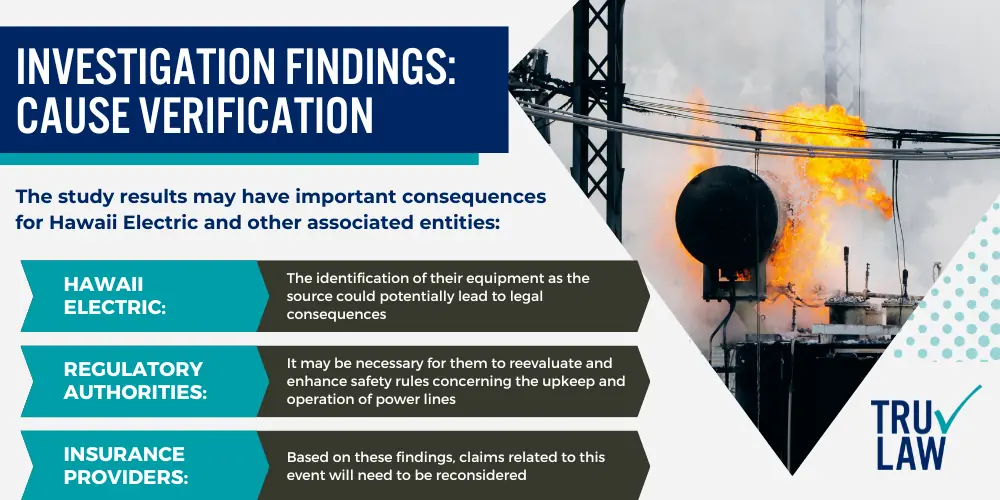
Specifically, a short circuit in one of the power lines of Hawaii Electric was identified as the origin of the fire.
This conclusion was not reached without careful consideration.
It was based on a considerable amount of scientific data collected from a range of different sources:
- Sensors that were installed in the proximity of the fire’s origin detected a sudden increase in electric current just moments before the fire started.
- The burn patterns around the base of the impacted power line were found to be consistent with those typically caused by an electrical ignition source.
- The analysis of the residue found at the scene revealed the presence of materials that are commonly found in electrical insulations.
The conclusions drawn from these findings were corroborated by experts in the field of forensic fire investigation.
These experts independently reviewed the findings and agreed with the conclusions that were reached.
Implications for Entities Involved
The study results may have important consequences for Hawaii Electric and other associated entities:
- Hawaii Electric: The identification of their equipment as the source could potentially lead to legal consequences, such as penalties or damage lawsuits.
- Regulatory Authorities: It may be necessary for them to reevaluate and enhance safety rules concerning the upkeep and operation of power lines.
- Insurance Providers: Based on these findings, claims related to this event will need to be reconsidered.
It is crucial to highlight that these consequences are severe, but they are integral to ensuring responsibility and preventing similar future occurrences.
The Aftermath: Rebuilding and Prevention
The Maui fire incident, which occurred in Lahaina and Kula, was a disastrous event that left a lasting impact on the local residents.
This incident resulted in numerous investigations, allegations, and counterclaims, all aimed at determining the responsible party and preventing similar events in the future.
As the recovery from this catastrophe continues, it is essential to draw lessons from it and put in place preventive measures.
The investigations have revealed that power companies such as Hawaii Electric have a responsibility to ensure that their equipment does not constitute a fire hazard.
Furthermore, residents should also be cognizant of potential dangers within their purview.
Through collective efforts, it is possible to reduce the risks associated with wildfires and safeguard our communities against such disasters in the future.
Maui Fire Lawsuit Frequently Asked Questions
-
The exact cause of the Maui fire is still under investigation.
However, several sources have provided insights into potential causes and contributing factors:
- Weather Conditions: The devastating Maui fires were influenced by a combination of weather conditions, including strong winds, dry vegetation, and low humidity.
- Electrical Issues: Reports suggest that bare electrical wire that could spark on contact and leaning poles on Maui were potential causes.
- Downed Power Lines: Some evidence suggests that sparks produced by a downed power line may have ignited at least one of the fires.
- Invasive Grasslands: Maui’s unmanaged invasive grasslands may have contributed to the rapid spread of the fire.
-
In the face of ongoing speculations, Hawaii Electric has issued a firm rebuttal, stating unequivocally that they have been diligent in conducting regular maintenance checks on their equipment.
This statement comes in response to allegations suggesting that the recent fire in Maui may have been precipitated by potential negligence on their part.
They follow a systematic procedure, meticulously examining every component for signs of wear and tear or any anomalies which could potentially compromise the system’s integrity.
While the exact cause of the fire in Maui remains under investigation, Hawaii Electric’s assertive response serves as a reminder of the importance of regular maintenance checks in preventing such incidents.
It emphasizes the role of proactive measures in averting potential disasters and ensuring public safety.
-
In order to prevent future fires, both government bodies and electricity companies are taking proactive steps.
To begin with, they are enforcing stricter regulations.
This means that there will be more rigid rules and guidelines in place that must be adhered to, which will help to reduce the risk of fires.
In addition to this, these organizations are also conducting more regular inspections of their equipment.
By doing this, they can identify any potential issues or hazards before they become a problem.
This will not only help to prevent fires, but it will also ensure that the equipment is working efficiently and safely.
Overall, these are the measures that are being taken to prevent future fires.
They are aimed at not only reducing the risk of fires, but also ensuring the safety and efficiency of the equipment.
It is important to note that these measures are ongoing, and are continually being reviewed and improved upon to ensure the highest level of safety.
-
Residents play a crucial role in fire prevention.
Here are some recommended steps from the American Red Cross on minimizing the risk of fires:
- Smoke Alarms: Install smoke alarms on every level of your home, inside bedrooms, and outside sleeping areas. Test them monthly and change the batteries as needed.
- Fire Escape Plan: Discuss and practice a fire escape plan with all family members. Ensure everyone knows two ways out of every room.
- Electrical Safety: Regularly check electrical cords and avoid overloading outlets. Hire a qualified electrician for any wiring changes.
- Maintain Lawn: Trim bushes and trees regularly, especially those close to the house.
- Fire-Resistant Materials: Use fire-resistant materials when building or renovating your home.
-
The Maui fire had a profound impact on its residents in various ways:
- Loss of Life: The wildfires that swept through parts of Maui are now considered the deadliest in modern U.S. history, killing more than 100 people.
- Displacement: The devastating wildfires displaced thousands of residents, leaving many without homes.
- Economic Challenges: Maui’s worst damage was in areas like Lahaina, Pulehu, and Upcountry. The county, which already faced affordable housing challenges, found these issues exacerbated after the disaster.
- Environmental Impact: The fires left behind a path of destruction that will have long-term environmental consequences.

Managing Attorney & Owner
With over 25 years of legal experience, Jessica Paluch-Hoerman is an Illinois lawyer, a CPA, and a mother of three. She spent the first decade of her career working as an international tax attorney at Deloitte.
In 2009, Jessie co-founded her own law firm with her husband – which has scaled to over 30 employees since its conception.
In 2016, Jessie founded TruLaw, which allows her to collaborate with attorneys and legal experts across the United States on a daily basis. This hypervaluable network of experts is what enables her to share the most reliable, accurate, and up-to-date legal information with our readers!
Additional Maui Fire Lawsuit resources on our website:
Here, at TruLaw, we’re committed to helping victims get the justice they deserve.
Alongside our partner law firms, we have successfully collected over $3 Billion in verdicts and settlements on behalf of injured individuals.
Would you like our help?
At TruLaw, we fiercely combat corporations that endanger individuals’ well-being. If you’ve suffered injuries and believe these well-funded entities should be held accountable, we’re here for you.
With TruLaw, you gain access to successful and seasoned lawyers who maximize your chances of success. Our lawyers invest in you—they do not receive a dime until your lawsuit reaches a successful resolution!
AFFF Lawsuit claims are being filed against manufacturers of aqueous film-forming foam (AFFF), commonly used in firefighting.
Claims allege that companies such as 3M, DuPont, and Tyco Fire Products failed to adequately warn users about the potential dangers of AFFF exposure — including increased risks of various cancers and diseases.
Depo Provera Lawsuit claims are being filed by individuals who allege they developed meningioma (a type of brain tumor) after receiving Depo-Provera birth control injections.
A 2024 study found that women using Depo-Provera for at least 1 year are five times more likely to develop meningioma brain tumors compared to those not using the drug.
Suboxone Tooth Decay Lawsuit claims are being filed against Indivior, the manufacturer of Suboxone, a medication used to treat opioid addiction.
Claims allege that Indivior failed to adequately warn users about the potential dangers of severe tooth decay and dental injuries associated with Suboxone’s sublingual film version.
Social Media Harm Lawsuits are being filed against social media companies for allegedly causing mental health issues in children and teens.
Claims allege that companies like Meta, Google, ByteDance, and Snap designed addictive platforms that led to anxiety, depression, and other mental health issues without adequately warning users or parents.
Transvaginal Mesh Lawsuits are being filed against manufacturers of transvaginal mesh products used to treat pelvic organ prolapse (POP) and stress urinary incontinence (SUI).
Claims allege that companies like Ethicon, C.R. Bard, and Boston Scientific failed to adequately warn about potential dangers — including erosion, pain, and infection.
Bair Hugger Warming Blanket Lawsuits involve claims against 3M — alleging their surgical warming blankets caused severe infections and complications (particularly in hip and knee replacement surgeries).
Plaintiffs claim 3M failed to warn about potential risks — despite knowing about increased risk of deep joint infections since 2011.
Baby Formula NEC Lawsuit claims are being filed against manufacturers of cow’s milk-based baby formula products.
Claims allege that companies like Abbott Laboratories (Similac) and Mead Johnson & Company (Enfamil) failed to warn about the increased risk of necrotizing enterocolitis (NEC) in premature infants.
Here, at TruLaw, we’re committed to helping victims get the justice they deserve.
Alongside our partner law firms, we have successfully collected over $3 Billion in verdicts and settlements on behalf of injured individuals.
Would you like our help?
